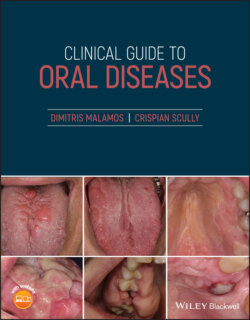Читать книгу Clinical Guide to Oral Diseases - Crispian Scully - Страница 50
Case 4.3
ОглавлениеFigure 4.3
CO: A 38‐year‐old woman was referred for white oral lesions and severe halitosis of one month's duration.
HPC: The white lesions were first found by her dentist following a detailed examination before receiving a kidney transplant. Her bad breath was first noticed by her husband over a year ago, and had become more obvious over the last five months when her kidney deteriorated.
PMH: An unhealthy married woman, suffering from chronic renal failure due to recurrent episodes of pyelonephritis and hypertension, anemia, and hypercalcemia; all these conditions were partially controlled with hemodialysis and medication.
OE: A thin lady with yellow to brown skin with an edema on her face and legs, showed a number of scattered white, undetached, oral lesions on the floor of her mouth, lateral margins of tongue and buccal mucosae (Figure 4.3). A bad smell was easily detected and had a characteristic fish‐like odor.
Q1 Which disease(s) below is/are associated with this fish odor?
1 Uncontrolled diabetes mellitus
2 Intestinal obstruction
3 Kidney insufficiency
4 Phenylketonurea
5 Alcoholic ketoacidosis
Answers:
1 No
2 No
3 Kidney insufficiency is the cause. Its failure is associated with high blood and saliva urea and nitrogen concentration. Degradation of these components release a number of volatile gases causing the characteristic uremic fish‐like odor which was reinforced by the xerostomia, a common finding in patients with kidney failure.
4 No
5 No
Comments: A great number of diseases are associated with bad breath, but the type of halitosis could be an indicator of certain diseases. A fruity odor is detected among patients with diabetes I or II and in alcoholic ketoacidosis; mouse odor in phenylketonurea and fish or fecal odor are commonly accompanied with kidney diseases or intestinal obstruction respectively.
Q2 Which other factors apart from urea can participate in fishy breath among patients with chronic kidney diseases (CKDs)?
1 Reduced flow rate
2 Type of dialysis treatment
3 Duration (acute vs. chronic)
4 Poor oral hygiene status
5 Electrolyte imbalance
Answers:
1 Reduced salivary flow rate (stimulated and unstimulated) is often found in CKDs. This hyposalivation allows the accumulation of sulfur producing bacteria within the mouth that are capable of producing urea, the basic component of fish odor.
2 No
3 No
4 Poor oral hygiene allows the accumulation of a number of bacteria, alters the pH of the biofilm matrix and causes tooth decay and gingival disease. All of these factors play an indirect role in halitosis production.
5 No
Comments: Halitosis is related to the severity and not to the duration or type of dialysis (peritoneal vs. hemodialysis). Electrolyte imbalance is a common finding but does not seem to play a role in halitosis.
Q3 Which is/or are the main component(s) of fish malodor?
1 Ketones
2 Cholines
3 Methylamines
4 Acetone
5 Carbon dioxide
Answers:
1 No
2 No
3 Methylamines (mono, di, or tri) are considered as the major components of uremic toxins which are poorly removed with dialysis and play an important role in the production of fish odor.
4 No
5 No
Comments: Acetone and other ketones are products of fatty metabolism in patients with uncontrolled diabetes where the metabolism of glucose is impaired due to low insulin synthesis. Carbon dioxide is the major gas component of exhaled air and altered in various conditions or diseases but has never been linked with fish odor.
